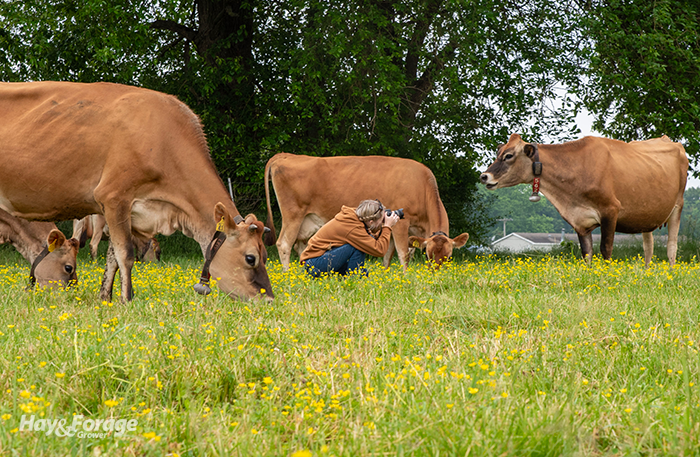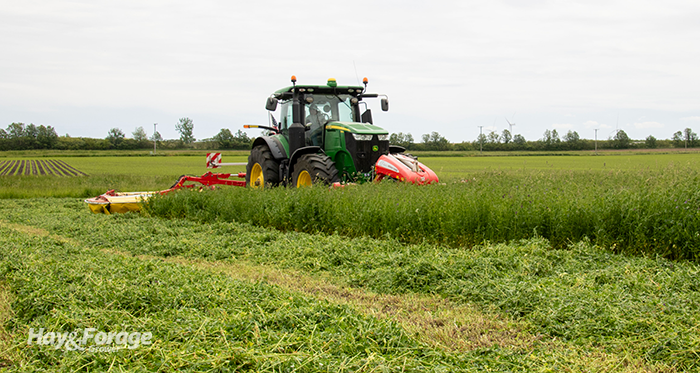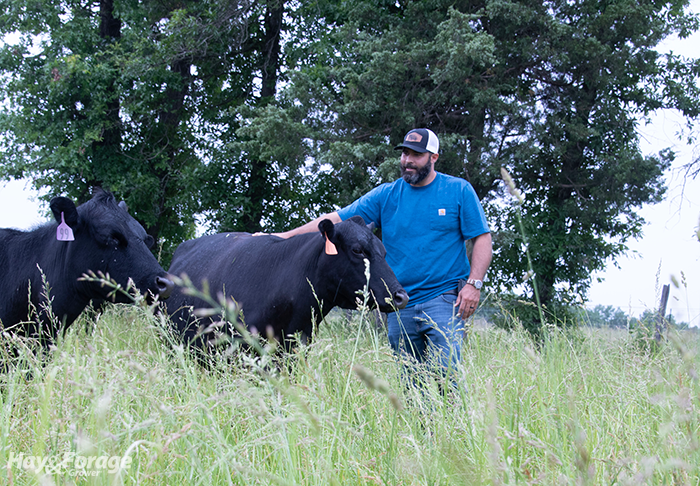Here’s what’s happening in the field |
| By Amber Friedrichsen, Managing Editor |
|
|
 Just like haymaking and grazing rotations are seasonal in nature, so too is the work of an agricultural journalist — especially those of us in the hay and forage business. As farmers enter hayfields with choppers and balers and cattle enter paddocks to graze lush pastures, we lace up our boots and follow the action with notebooks in hand and cameras in tow. As such, the editors of Hay & Forage Grower, Hoard’s Dairyman, and the Journal of Nutrient Management embark on what we call “The Photo Trip” every year. We pick a region of the Midwest and locate farms to visit as the growing season shifts into third gear. As the name of the annual adventure implies, the primary goal of our photo excursion is to gather stock photos to use in magazine stories, e-newsletters, and on our respective websites throughout the year. In addition to photos, we often come home with several leads for farm stories, as well as a few funny travel stories of our own. The trip is equal parts team bonding and boots-on-the-ground experience, although the weather sometimes thwarts the latter component. Such was the case this year as the seven-day forecast across our road trip route through central Illinois and eastern Missouri was mostly cloudy with a persistent chance of rain. Previous precipitation kept haymakers from cutting forage to avoid baling rained-on hay in the days before our arrival, and looming weather prevented them from starting fieldwork during our visits. Thus, we returned with fewer equipment pictures than we hoped for. We experienced the wetness firsthand on the third day of our trip when a light but steady sprinkle fell on our shoulders — and our cameras — while we marched through the spring flush of forage on two Missouri beef farms. Wet jeans and soggy socks are a small price to pay to get a good shot of grazing cattle. With that said, there was no shortage of hay and forage gleanings to be made, and after trekking home on a seemingly never-ending stretch of I-39 and doing a much needed load of laundry, I’ve reflected on some of the recurring themes, early season successes, and inevitable challenges faced by the farmers we met. The following includes just a few of the forage-related observations from this year’s rendition of The Photo Trip. Late to the hay game It was hard to believe that first cutting had just been completed or was yet to begin considering the amount of down hay I’ve seen in southern Wisconsin and eastern Iowa since mid-May. But the hay farms and dairies we stopped at in central Illinois and eastern Missouri had all been facing similar rain delays since the start of the season. An overwhelming sense of surrender to Mother Nature could be felt from the farmers who had no choice but to park their tractors until the wet soil dried out and the chance of rain retreated. A young haymaker near Compton, Illinois, satisfied our picture-taking needs by cutting a small patch of an alfalfa-grass mix one afternoon so we could get a few good shots of a mower in action, but he wasn’t about to venture any father into other hayfields with the weatherman calling for rain overnight. It was a good call on his part as the area received three-tenths of an inch of rain by morning. With a customer base largely comprised of horse owners in Tennessee and Kentucky, his second and third cuttings of good-looking grass hay made into small square bales will be of greater concern from his standpoint, anyway.  Brandon Heiman, owner of The Hay Barn in Compton, Ill., mows a few acres of hay but held off on cutting any more forage to avoid impending rain. An Illinois dairy located three hours south started their hay season in slow motion this spring, too. The farmer there mentioned that during most years, they would typically be getting ready for second cutting. As of our visit on the last Wednesday in May, they had just buttoned up their first harvest. No shortage of native grasses As we got farther into tall fescue territory of eastern Missouri, I was surprised by the prevalence of native warm-season grasses established in rotational grazing systems. Although a viable tactic to mitigate the toxic effects of endophyte-infected tall fescue that ramp up with summer weather, I have heard more about seeding native grasses than I have witnessed in-person. One farmer just east of the Ozarks was grazing one of the best stands of native warm-season grasses any of us had ever seen — especially considering he had just planted the mix of big bluestem, little bluestem, and indiangrass last spring. He attributed the lush growth to good timing of tall fescue termination and optimal conditions during the seeding year, which was a humble statement considering the waist-high grass growth and incredible volume of forage we found ourselves standing in.  This stand of big bluestem, indiangrass, and little bluestem in Missouri was on full display as cows grazed during a light rain. Another Missouri farmer boasted a 40-plus species mix that he had established in his pastures, which included both cool- and warm-season native grasses, dozens of forbs, and some legumes. After one pass through the cool-season species in early spring, he rotates his sheep and cattle through the diversified paddocks several weeks later when the warm-season species hit their growth curve. Both farmers sang the praises of native forages, especially when introduced species like tall fescue can’t beat the heat. Beefy beef prices Although we aim to schedule stops at a variety of operations during The Photo Trip, the bulk of our schedule was comprised of time spent on beef farms this year. Most of these pastures were clearly understocked, which was a function of historically high beef prices and the fear of having too much supply and not enough demand. With a lot of grass and fewer cattle of his own, one Missouri farmer started custom grazing stockers and heifers for a neighbor, which doubled as a good use of the spring flush. Another farmer admitted he would just wait until prices returned to normal before restocking his herd to make the best use of his grass. The cattle market may be cyclical like any other, but as most producers know, there really is no such thing as normal.  Cody Jones of Kingdom City, Mo., introduced us to his favorite cow. Jones raises registered Angus cattle, sells seedstock, and custom grazes heifers. Between weather patterns, forage growth, and market outlooks, this year’s Photo Trip reinforced the dedication it takes to be successful in the hay and forage game. No two hay cuttings, grazing rotations, or growing seasons are the same, which is why an open mind and flexible approach are necessary to play the cards that are dealt. Bonus puppy love I would be remiss not to mention that not one but two farms we visited had just produced a litter of puppies. One had a group of Australian cattle dogs — also known as red and blue heelers — and another had a litter of Maremma sheepdogs. Many a good farm has a good farm dog, and these stops were no exception.  These Maremma sheepdog puppies were one of the highlights of this year’s Photo Trip. |
